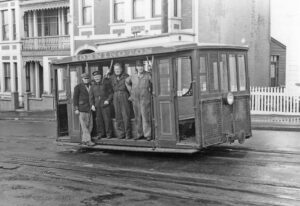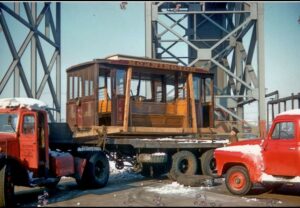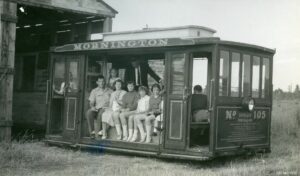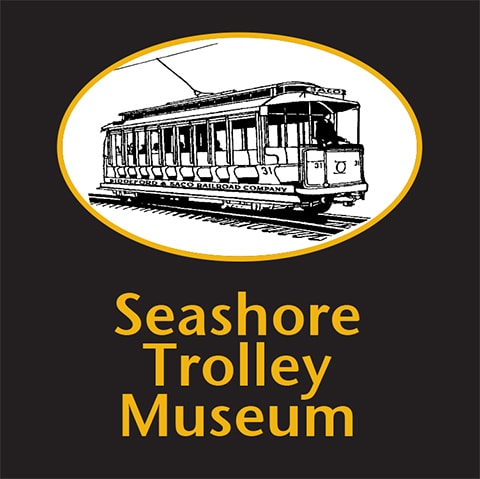
No. 105 in service; Leo Sullivan photo.
Operating History: In 1881, Dunedin, New Zealand became the second city in the world, after San Francisco, to operate cable cars. No. 105 (originally No. 5) was built for the Mornington Borough Council in 1903 to replace older cars destroyed in a fire. No. 105 was designed for one-man operation which was very unusual for a cable car. The 3’ 6” gauge car carried 18 passengers at 8 to 10 miles per hour. The short car was equipped with a single truck. The City Corporation Tramways of Dunedin took over the operation in 1916. No. 105 ran on the city’s Maryhill line most of its life. The Maryhill line was only a half-mile long. Locals sometimes referred to it as “the Big Dipper,” going steeply down one side of a valley and then up the other side. After the Maryhill line closed in 1955, No. 105 moved to the Mornington line, Dunedin’s last operating cable route. The Mornington line included a 28 percent grade, one of the steepest cable grades in the world. No. 105 had a “convertible” grip which could be set at two different heights to allow it to run of either line. Cable car service ended in 1957, making Dunedin the last city, other than San Francisco, to operate cable cars.
Museum Ownership: Dunedin had been a favorite liberty port for thousands of American G.I.s in the South Pacific during World War II. So, in 1957, the City of Dunedin donated No. 105 to the United States for custody by Seashore in memory of U.S. naval, marine and army personnel. No. 105 came to the U.S. in January 1958 on New Zealand Shipping Company’s M.V. Wangaroa. No. 105 was exhibited at the New England Sportsmen’s and Boat Show at Boston’s Mechanics Hall. On February 3, during the show, Sir Leslie Munro, New Zealand’s ambassador to the U.S. and former president of the United Nations General Assembly, ceremonially presented No. 105 to Governor Foster Furcolo of Massachusetts and A. Edward Langlois, representing Governor Edmund Muskie of Maine. For lunch on Feb. 3, Seashore members organized an informal state luncheon at Boston’s Hotel Statler for Sir Leslie and Lady Monro, Governor Furcolo and representatives of the British Commonwealth nations, the U.S. armed forces and New England businesses. A marine-navy color guard and Scots bagpipers welcomed the luncheon guests. At the presentation ceremony, Sir Leslie gave Mr. Langlois the original cable hook from the car. After the Sportsmen’s show, No. 105 was trucked to Seashore. No. 105 is one of two cable cars at Seashore; the other is California Street Cable Railroad No. 48. At 16’ 6” long, No. 105 is Seashore’s smallest rail passenger vehicle. Dunedin cable car No. 105, which also ran on the Maryhill line, is preserved at the Otago Early Settlers Museum in Dunedin.
Current Condition: No. 105 is in Riverside Carhouse on display. The car’s cable grip is next to the car.

No. 105 in Boston under the Tobin Bridge, 1958; Foster Palmer photo.

No. 105 at Seashore, 1960s; Foster Palmer collection.
 |
 |
 |
